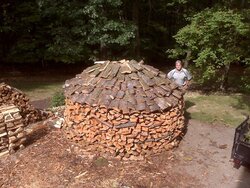I think I'm going to put some firewood splits down as stringers with gaps in between for drainage and follow the land contour.
A pain, but I cant see doing all that shimming and/or messing with pallets, ladders, etc.
A pain, but I cant see doing all that shimming and/or messing with pallets, ladders, etc.



